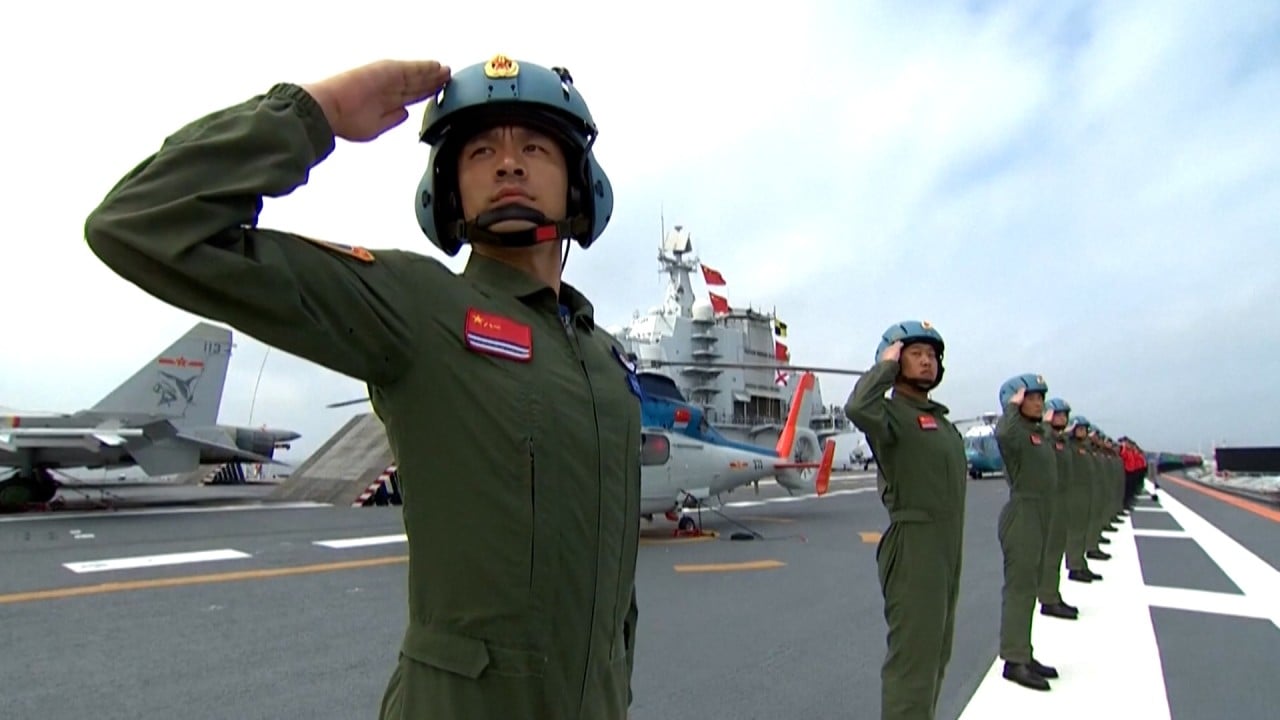
01:22
China ramps up training of carrier fighter jet pilots to bolster PLA navy

Recent images of a stealth fighter jet at a naval airbase suggest China has begun pilot training preparations for a fourth aircraft carrier, defence experts say.
China is known to be developing its third and largest carrier, the Type 003, with sea trials expected soon. Whether work has started on a Type 004 is not yet clear.
Satellites in March spotted two FC-31 Gyrfalcon stealth fighters lined up alongside several J-15 carrier-based fighter jets at the People’s Liberation Army (PLA) flight training facility in Liaoning province, offering a comparative view of the two models for the first time.
The two FC-31s – fifth-generation stealth aircraft – appeared to be slightly shorter than the J-15s, with their dark grey livery identifying them as stealth warplanes.
Their appearance side by side hinted that the FC-31 might also become a ship-borne fighter jet after the J-15, the “Flying Shark” strike fighter flown by China’s existing aircraft carriers, the Liaoning and Shandong.
The joint appearance of the FC-31 and J-15s could also be a sign that China was making operational preparations for a fourth aircraft carrier, defence experts and sources said.
Sea trials for the Type 003 later this year are expected to serve as reference points for future Chinese aircraft carriers. China plans to build at least four aircraft carrier strike groups by 2030 to become the world’s second-biggest modern blue water navy after the United States.
Like the Liaoning and Shandong, the Type 003 aircraft carrier is still a conventional diesel-powered platform, while its successor is likely to be equipped with nuclear reactors.
The PLA Naval Aviation Testing and Training Complex where the jets were photographed has been dubbed China’s own “Nitka” – after the Soviet-era training range in the Crimea that was the model for the Chinese base.
Satellite images showed the PLA naval pilot training site to be equipped with Soviet-designed ski-jump simulating ramps and catapult systems suited to the flat-top flight decks seen on American aircraft carriers.
Mainland social media buzzed with speculation over whether the FC-31 would be the carrier-based fighter jet for the Type 003.
But a source close to the navy said the J-15 would remain the sole active ship-borne fighter jet for the Type 003, as well as the Liaoning and Shandong.
“The FC-31 is still a test aircraft that is yet to be reserved by the PLA Air Force or Navy under their formal development programmes,” the source said.
Developed by the Shenyang Aircraft Corporation (SAC) over more than a decade, the FC-31 took off on its first test flight in 2012, two years before making its public debut at the 2014 biannual international air show in Zhuhai, Guangdong province.
The J-15 Flying Shark, also developed by the SAC, is just a copycat version of the Russian Sukhoi-33 developed in the 1970s, according to Andrei Chang, editor-in-chief of the Canada-based Kanwa Asian Defence monthly.
“Even the FC-31 imitates the shape and design of the American F-35 [stealth fighter],” he said.
“Russian aircraft designer Mikhail Pogosyan, who designed the Su-33 and other new generation aircraft, told me that there is a rule that the performance of copycats would never surpass the original designs,” Chang added. “How can the SAC convince the PLA Navy to trust them?”
Beijing-based naval expert Li Jie said flight safety was another key concern. “It’s too risky to fly new aircraft on a totally newly designed aircraft carrier.”